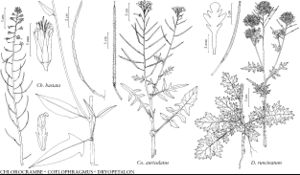Coelophragmus
in H. G. A. Engler, Pflanzenr. 86[IV,105]: 157, fig. 25. 1924.
| Taxon | Illustrator ⠉ | |
|---|---|---|
 | Chlorocrambe hastata Coelophragmus auriculatus Dryopetalon runcinatum | Yevonn Wilson-Ramsey Yevonn Wilson-Ramsey Yevonn Wilson-Ramsey |
Annuals; not scapose; glabrous or pilose. Stems erect, unbranched or branched distally. Leaves basal and cauline; petiolate; basal not rosulate, blade margins pinnatifid or runcinate, lobes dentate or entire; cauline blade (base auriculate or amplexicaul), margins similar to basal. Racemes (corymbose), considerably elongated in fruit. Fruiting pedicels horizontal, stout. Flowers: sepals erect to ascending, oblong, lateral pair not saccate basally; petals white to lavender, (longer than sepals), spatulate, claw and blade obscurely differentiated; stamens tetradynamous; filaments dilated basally; anthers oblong; nectar glands: lateral annular, median glands confluent with lateral. Fruits sessile or shortly stipitate, linear, straight, terete; valves each with distinct midvein; replum rounded; septum complete, (deeply partitioned between seeds); ovules 78–120 per ovary; style distinct; stigma capitate, deeply 2-lobed. Seeds uniseriate, plump, not winged, ovoid; seed-coat not mucilaginous when wetted; cotyledons incumbent.
Discussion
Species 1.
Coelophragmus was described as consisting of two species. The type of one, C. umbrosus O. E. Schulz (1924), belongs in Dryopetalon and is conspecific with the type of D. runcinatum A. Gray (1853). Because removal of that species does not constitute effective lectotypification of the genus name, C. auriculatus O. E. Schulz is designated here as type of Coelophragmus.
Although Coelophragmus auriculatus was originally described as Sisymbrium auriculatum and recognized as such by every North American botanist, including E. B. Payson (1922) and R. C. Rollins (1993), the species clearly is not a Sisymbrium (S. I. Warwick et al. 2002, 2006b), a genus almost exclusively restricted to the Old World. Coelophragmus is recognized herein as a monotypic genus, and its affinities are nearest Dryopetalon (I. A. Al-Shehbaz et al. 2006). It is unique among all North American genera of the family by having fruit septums deeply partitioned between seeds.
Selected References
None.
Lower Taxa
"elongated" is not a number."thick" is not a number.